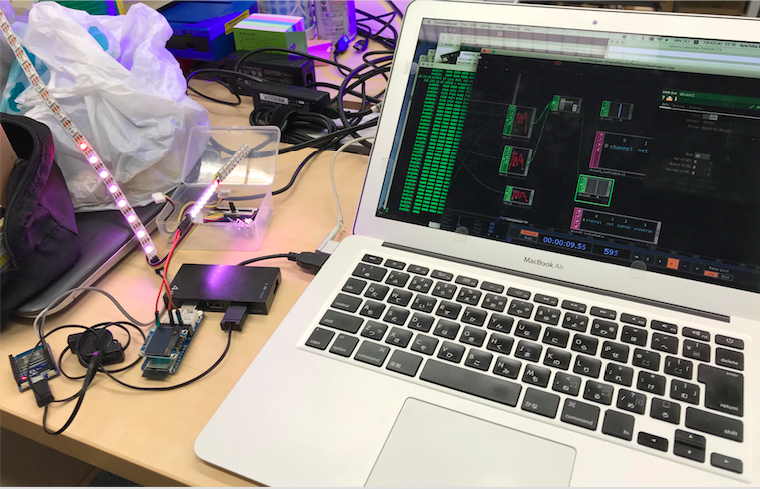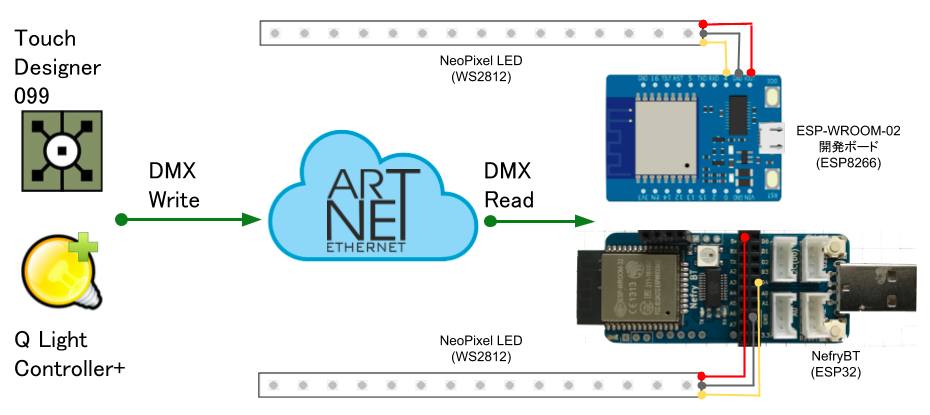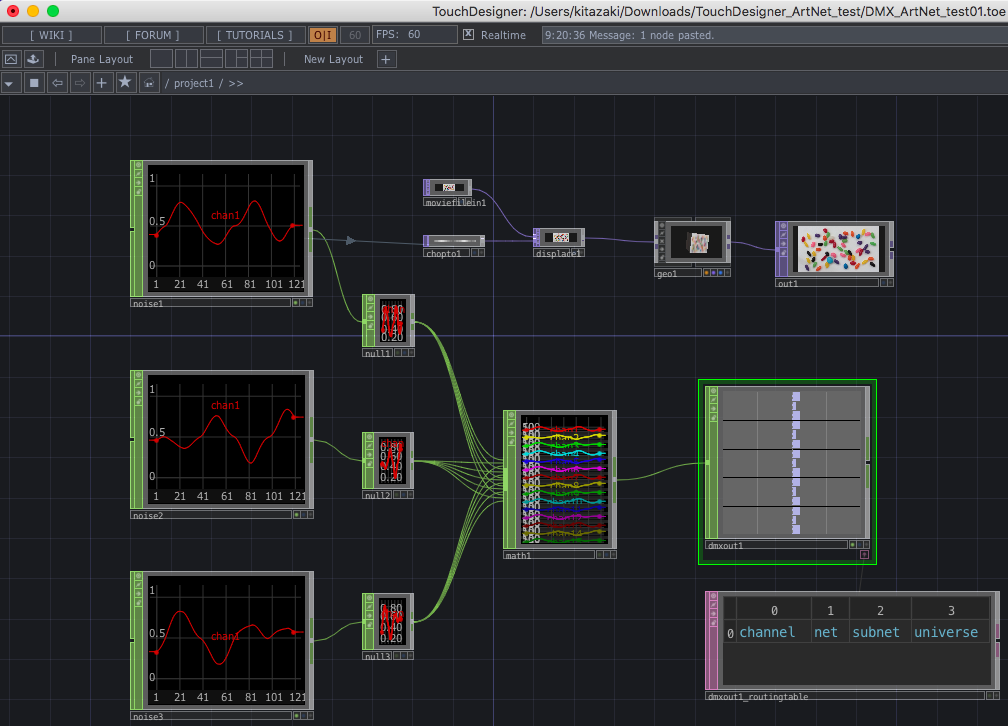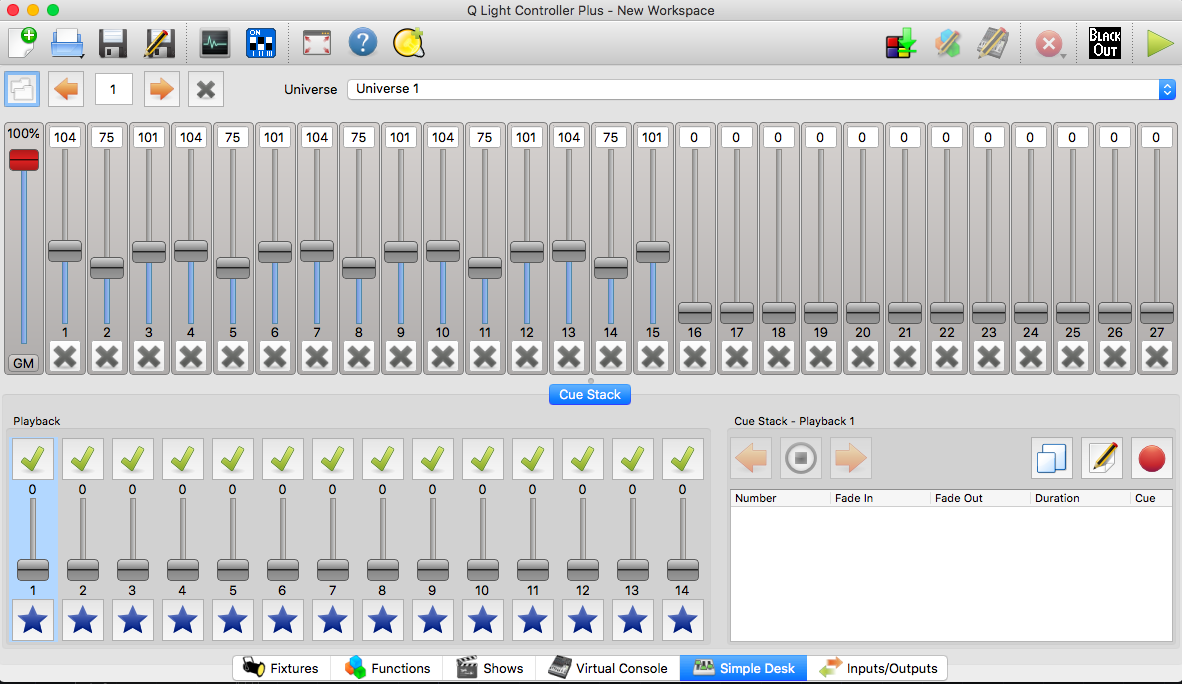ArtNet DMX (舞台照明などの設備制御で使用されるDMXのネットワーク実装プロトコル) を使用して TouchDesigner / QLC+ (Q Light Controller+) から ESP8266 / ESP32 に接続された NeoPixel LEDテープ(WS2812) を Lチカ してみた。
接続構成・配線図
ESP8266 は ESP-WROOM-02 開発ボード を、ESP32 は Nefry BT を、使用した。Nefry BT はリビジョンが存在し、リビジョンによってピン配列が異なるので こちら でチェック。( 今回は無印 (R1) を使用した。)
接続ピン
ESP-WROOM-02 開発ボード
VOUT(5V)、GND、IO4(GPIO4) を使用。
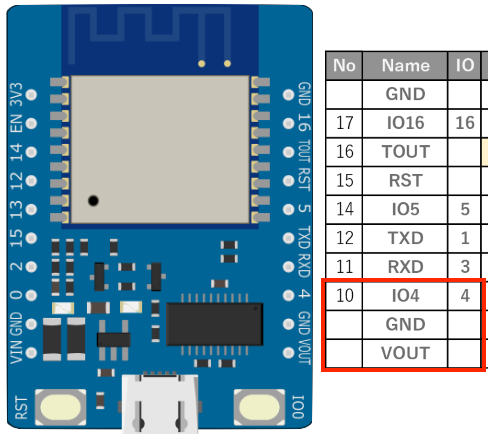
Nefry BT (R1)
5V、GND、D4(GPIO18) を使用。
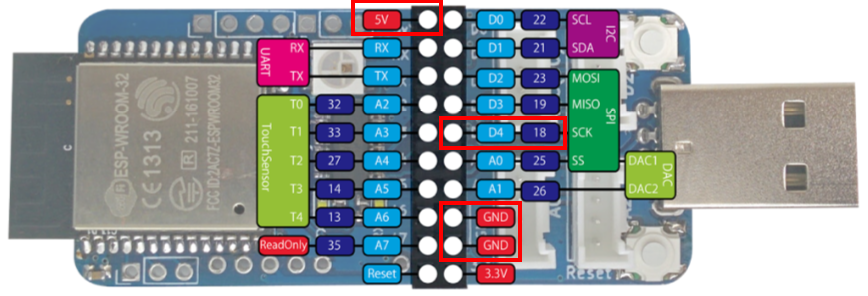
NeoPixel LED (WS2812)
+5V、GND、DI を使用。

TouchDesighner
DMX Out オペレータのパラメータ(DMXタブ)
Interface は Art-Net を選択する。
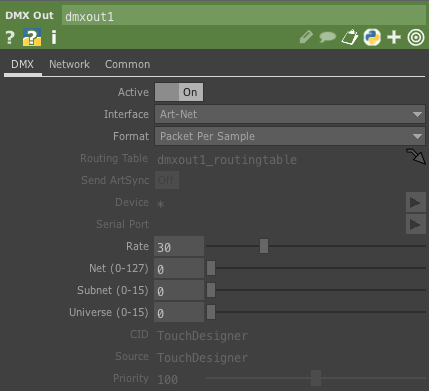
DMX Out オペレータのパラメータ (Networkタブ)
Network Address を適切に設定する。(ネットワーク全体 = ブロードキャストの場合は 255.255.255.255)

QLC+
Inputs/Outputs タブの Mapping
Plugin の ArtNet の Output にチェックする。
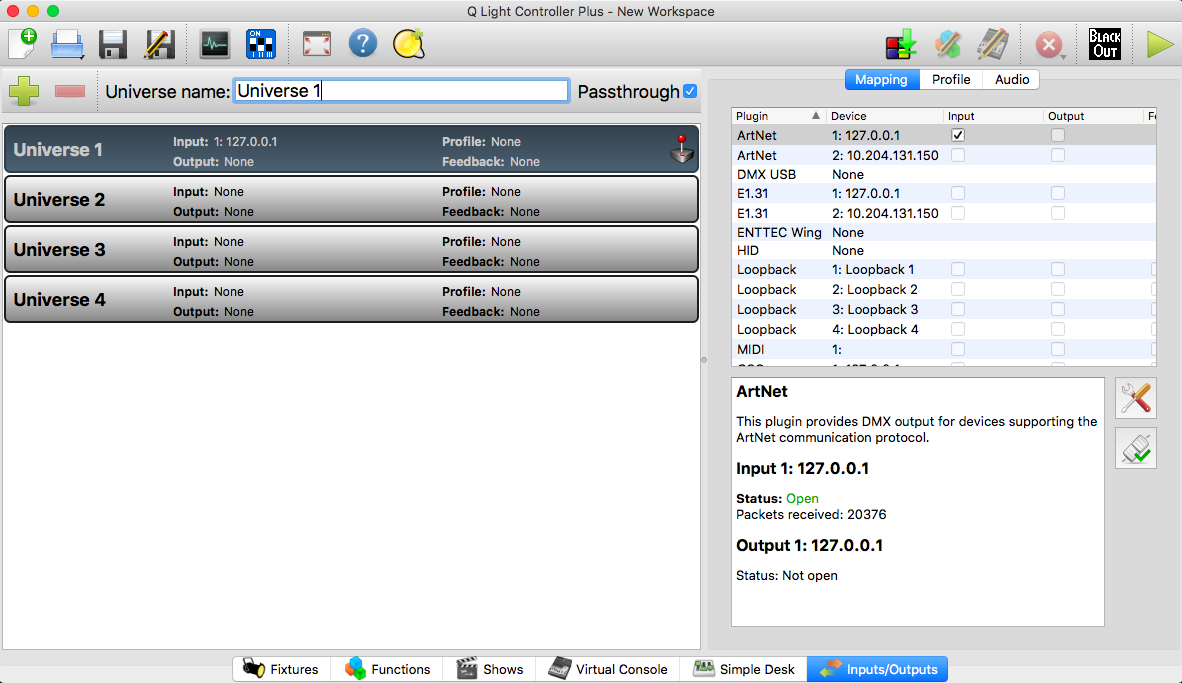
ソースコード
前提条件として ArtNet WiFi ライブラリ と FastLED ライブラリ が必要になるので、Arduino IDE を使用している場合は、ライブラリをダウンロードして「スケッチ」→「ライブラリをインクルード」→「ZIP形式のライブラリをインストール」の手順でインストールする。(参考)
ESP8266 のサンプルコードは こちら。
ESP32 のサンプルコードは こちら。
TouchDesigner のサンプルファイルは こちら。
# include <ESP8266WiFi.h>
# include <WiFiUdp.h>
# include <ArtnetWifi.h>
# include <FastLED.h>
// Wifi settings - be sure to replace these with the WiFi network that your computer is connected to
const char* ssid = ""; // Wi-Fi SSID
const char* password = ""; // Wi-Fi Password
// LED Strip
const int numLeds = 20; // Change if your setup has more or less LED's
const int numberOfChannels = numLeds * 3; // Total number of DMX channels you want to receive (1 led = 3 channels)
# define DATA_PIN 4 // The data pin that the WS2812 strips are connected to.
// ESP-WROOM-02 Dev.Board D4=GPIO4
CRGB leds[numLeds];
// Artnet settings
ArtnetWifi artnet;
const int startUniverse = 0;
bool sendFrame = 1;
int previousDataLength = 0;
// connect to wifi – returns true if successful or false if not
boolean ConnectWifi(void)
{
boolean state = true;
int i = 0;
WiFi.begin(ssid, password);
Serial.println("");
Serial.println("Connecting to WiFi");
// Wait for connection
Serial.print("Connecting");
while (WiFi.status() != WL_CONNECTED) {
delay(500);
Serial.print(".");
if (i > 20){
state = false;
break;
}
i++;
}
if (state){
Serial.println("");
Serial.print("Connected to ");
Serial.println(ssid);
Serial.print("IP address: ");
Serial.println(WiFi.localIP());
} else {
Serial.println("");
Serial.println("Connection failed.");
}
return state;
}
void onDmxFrame(uint16_t universe, uint16_t length, uint8_t sequence, uint8_t* data)
{
sendFrame = 1;
// set brightness of the whole strip
if (universe == 15)
{
FastLED.setBrightness(data[0]);
}
// read universe and put into the right part of the display buffer
for (int i = 0; i < length / 3; i++)
{
int led = i + (universe - startUniverse) * (previousDataLength / 3);
if (led < numLeds)
{
leds[led] = CRGB(data[i * 3], data[i * 3 + 1], data[i * 3 + 2]);
}
}
previousDataLength = length;
FastLED.show();
}
void setup()
{
Serial.begin(115200);
ConnectWifi();
artnet.begin();
FastLED.addLeds<WS2812, DATA_PIN, GRB>(leds, numLeds);
// onDmxFrame will execute every time a packet is received by the ESP32
artnet.setArtDmxCallback(onDmxFrame);
}
void loop()
{
// we call the read function inside the loop
artnet.read();
}
# include <WiFi.h>
# include <WiFiUdp.h>
# include <ArtnetWifi.h>
# include <FastLED.h>
// Wifi settings - be sure to replace these with the WiFi network that your computer is connected to
const char* ssid = ""; // Wi-Fi SSID
const char* password = ""; // Wi-Fi Password
// LED Strip
const int numLeds = 20; // Change if your setup has more or less LED's
const int numberOfChannels = numLeds * 3; // Total number of DMX channels you want to receive (1 led = 3 channels)
# define DATA_PIN 18 // The data pin that the WS2812 strips are connected to.
// NefryBT D4=GPIO18
CRGB leds[numLeds];
// Artnet settings
ArtnetWifi artnet;
const int startUniverse = 0;
bool sendFrame = 1;
int previousDataLength = 0;
// connect to wifi – returns true if successful or false if not
boolean ConnectWifi(void)
{
boolean state = true;
int i = 0;
WiFi.begin(ssid, password);
Serial.println("");
Serial.println("Connecting to WiFi");
// Wait for connection
Serial.print("Connecting");
while (WiFi.status() != WL_CONNECTED) {
delay(500);
Serial.print(".");
if (i > 20){
state = false;
break;
}
i++;
}
if (state){
Serial.println("");
Serial.print("Connected to ");
Serial.println(ssid);
Serial.print("IP address: ");
Serial.println(WiFi.localIP());
} else {
Serial.println("");
Serial.println("Connection failed.");
}
return state;
}
void onDmxFrame(uint16_t universe, uint16_t length, uint8_t sequence, uint8_t* data)
{
sendFrame = 1;
// set brightness of the whole strip
if (universe == 15)
{
FastLED.setBrightness(data[0]);
}
// read universe and put into the right part of the display buffer
for (int i = 0; i < length / 3; i++)
{
int led = i + (universe - startUniverse) * (previousDataLength / 3);
if (led < numLeds)
{
leds[led] = CRGB(data[i * 3], data[i * 3 + 1], data[i * 3 + 2]);
}
}
previousDataLength = length;
FastLED.show();
}
void setup()
{
Serial.begin(115200);
ConnectWifi();
artnet.begin();
FastLED.addLeds<WS2812, DATA_PIN, GRB>(leds, numLeds);
// onDmxFrame will execute every time a packet is received by the ESP32
artnet.setArtDmxCallback(onDmxFrame);
}
void loop()
{
// we call the read function inside the loop
artnet.read();
}
まとめ
TouchDesigner などのノード系ビジュアルプログラミングソフトや QLC+ などの照明設備制御ソフトと IoT デバイスとの相性は非常に良いことが分かったので、今後 "よさみ" がさらに深まれば幸いです。
